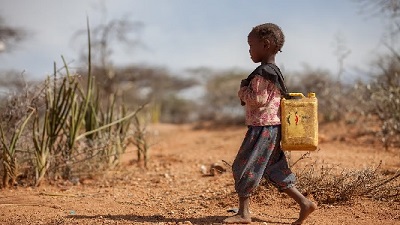The perfect storm
Publish date 11-10-2022
 There is not only the crisis in Ukraine, the Horn of Africa is facing an unprecedented tragedy. It is a real perfect storm that combines the nefarious outcomes of the Covid pandemic with the war in Tigray and a famine due to the blockade of aid in the warring region and the drought that caused the loss of 4 consecutive harvests in Somalia, in some areas. of Kenya, in part of Ethiopia and Eritrea. At this point comes the blockade of Ukrainian wheat that these countries imported exclusively for the low price. At this time it was replaced by cereals from other countries, but at higher prices, resulting in an increase in food prices of up to 200% in Ethiopia and Somalia. Estimates of humanitarian organizations speak of at least 800 thousand people at risk of acute malnutrition in Somalia. They are people who have to kill livestock and move to large urban centers where they traditionally think they can receive food, which this time is not there.
There is not only the crisis in Ukraine, the Horn of Africa is facing an unprecedented tragedy. It is a real perfect storm that combines the nefarious outcomes of the Covid pandemic with the war in Tigray and a famine due to the blockade of aid in the warring region and the drought that caused the loss of 4 consecutive harvests in Somalia, in some areas. of Kenya, in part of Ethiopia and Eritrea. At this point comes the blockade of Ukrainian wheat that these countries imported exclusively for the low price. At this time it was replaced by cereals from other countries, but at higher prices, resulting in an increase in food prices of up to 200% in Ethiopia and Somalia. Estimates of humanitarian organizations speak of at least 800 thousand people at risk of acute malnutrition in Somalia. They are people who have to kill livestock and move to large urban centers where they traditionally think they can receive food, which this time is not there.
Without forgetting the darkened tragedy of the Tigris. Hospitals closed in Macallè due to lack of medicines, children dying in the street of hunger, according to the news that filter through, recounting an ignored humanitarian catastrophe, but with few equals on the planet to follow of the civil war that broke out in November 2020. And according to Save the children , hunger also extends to eastern and south-eastern Ethiopia where malnutrition rates have soared in recent months due to drought, conflict and displacements. According to estimates, about 185 thousand children suffer from it.
If the truce in Tigrai declared by the central government of the Nobel Peace Prize 2019 Abiy Ahmed in March manages to hold, humanitarian aid from Addis Ababa continues to arrive in fits and starts in the rebel region. At least two million are displaced by the conflict and humanitarian agencies say they have sent aid for 800,000 people. Meanwhile, FAO and World Food Program reiterate, malnutrition affects the majority of the seven million Tigrayans, considered dependent on humanitarian assistance. As a result of the conflict, international agencies estimate that grain production in the Northwestern Ethiopian region has dropped by 60%. Scenarios of extreme misery from which we will come out, if peace comes, at least in five or six years and as long as the drought also ceases.The health situation remains dramatic also in the Afar region, bordering the Tigris, where last autumn was the counter-offensive of the Tigrinya defense forces passed which, to avenge the destruction and mass slaughter of civilians by the federal army of the Eritrean allies, Afar and Amhara, destroyed 90% of the health facilities.
The will for peace is there, but it is proceeding too slowly. One of the thorniest topics of negotiation will be the Western Tigray, disputed by the Amhara - iron allies of Oromo Abiy - who have occupied it and where ethnic cleansing and crimes against humanity would continue, as denounced by a joint report by Amnesty International and Human rights watch in April. Peace with the Tigrayans would also displease the Eritrean dictator Isayas Afewerki, an ally of Abiy, whose troops at the border have already clashed with the regional forces of the Tigris in recent weeks. The report on human rights in Eritrea presented last June 13 to the UN denounces a worsening of the repression in the former Italian colony, with mass recruitment of minors in roundups (giffa) house by house to send to force new recruits to fight. Let's not forget this land that has all the potential to become the door and the pearl of Africa.
Paolo Lambruschi
NP June-July 2022







